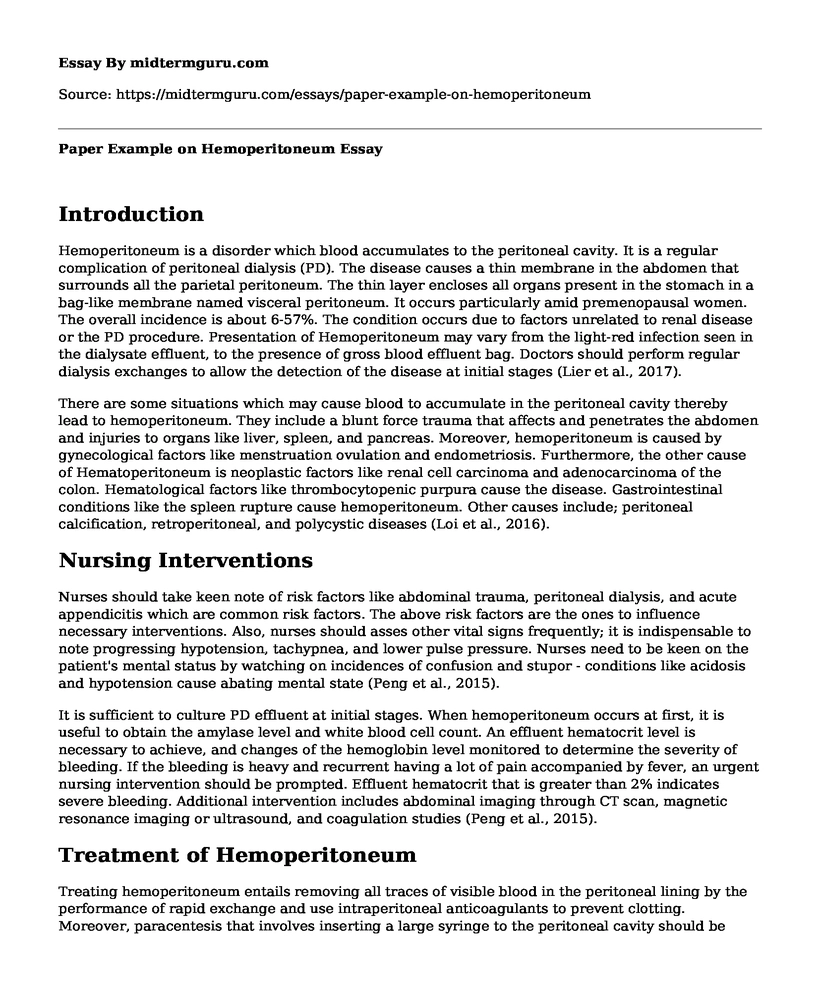Introduction
Hemoperitoneum is a disorder which blood accumulates to the peritoneal cavity. It is a regular complication of peritoneal dialysis (PD). The disease causes a thin membrane in the abdomen that surrounds all the parietal peritoneum. The thin layer encloses all organs present in the stomach in a bag-like membrane named visceral peritoneum. It occurs particularly amid premenopausal women. The overall incidence is about 6-57%. The condition occurs due to factors unrelated to renal disease or the PD procedure. Presentation of Hemoperitoneum may vary from the light-red infection seen in the dialysate effluent, to the presence of gross blood effluent bag. Doctors should perform regular dialysis exchanges to allow the detection of the disease at initial stages (Lier et al., 2017).
There are some situations which may cause blood to accumulate in the peritoneal cavity thereby lead to hemoperitoneum. They include a blunt force trauma that affects and penetrates the abdomen and injuries to organs like liver, spleen, and pancreas. Moreover, hemoperitoneum is caused by gynecological factors like menstruation ovulation and endometriosis. Furthermore, the other cause of Hematoperitoneum is neoplastic factors like renal cell carcinoma and adenocarcinoma of the colon. Hematological factors like thrombocytopenic purpura cause the disease. Gastrointestinal conditions like the spleen rupture cause hemoperitoneum. Other causes include; peritoneal calcification, retroperitoneal, and polycystic diseases (Loi et al., 2016).
Nursing Interventions
Nurses should take keen note of risk factors like abdominal trauma, peritoneal dialysis, and acute appendicitis which are common risk factors. The above risk factors are the ones to influence necessary interventions. Also, nurses should asses other vital signs frequently; it is indispensable to note progressing hypotension, tachypnea, and lower pulse pressure. Nurses need to be keen on the patient's mental status by watching on incidences of confusion and stupor - conditions like acidosis and hypotension cause abating mental state (Peng et al., 2015).
It is sufficient to culture PD effluent at initial stages. When hemoperitoneum occurs at first, it is useful to obtain the amylase level and white blood cell count. An effluent hematocrit level is necessary to achieve, and changes of the hemoglobin level monitored to determine the severity of bleeding. If the bleeding is heavy and recurrent having a lot of pain accompanied by fever, an urgent nursing intervention should be prompted. Effluent hematocrit that is greater than 2% indicates severe bleeding. Additional intervention includes abdominal imaging through CT scan, magnetic resonance imaging or ultrasound, and coagulation studies (Peng et al., 2015).
Treatment of Hemoperitoneum
Treating hemoperitoneum entails removing all traces of visible blood in the peritoneal lining by the performance of rapid exchange and use intraperitoneal anticoagulants to prevent clotting. Moreover, paracentesis that involves inserting a large syringe to the peritoneal cavity should be done. The fluid from the peritoneal cavity is drawn by pulling the plunger. Other means of treating the disease involves practicing ligation whereby the blood vessel which causes bleeding will be clamped or tied off (Kim & Lee, 2017).
Moreover, emphasis should be put on cauterization which involves burning of the tissue to close it off so that bleeding stops. Doctors could use laparotomy which entails making an incision to the patient's abdomen to drain all the fluids accumulating in the gut. Laparotomy can also be useful to diagnose hemoperitoneum. Oral contraceptives should be recommended to control bleeding and prevent ovulation. Moreover, aspirin with other systemic anticoagulants needs to be stopped whenever possible. Contrary to the aforementioned, coagulant medications should be used to slow or either stop the bleeding process. If the bleeding condition persists, then the patient has to undergo a surgical treatment intervention (Kim & Lee, 2017).
References
Kim, M., & Lee, J. (2017). EP25. 05: Sonographic markers in the treatment of hemoperitoneum caused by corpus luteal cyst rupture. Ultrasound in Obstetrics & Gynecology, 50(S1), 375-375.
Loi, E. S., Darwish, B., Abo, C., Millischer-Bellaiche, A. E., Angioni, S., & Roman, H. (2016). Recurrent hemoperitoneum during pregnancy in large deep endometriosis infiltrating the parametrium. Journal of minimally invasive gynecology, 23(4), 643-646.
Lier, M. C., Brosens, I. A., Mijatovic, V., Habiba, M., & Benagiano, G. (2017). Decidual bleeding as a cause of spontaneous hemoperitoneum in pregnancy and risk of preterm birth. Gynecologic and obstetric investigation, 82(4), 313-321.
Peng, C. R., Chen, C. P., Wang, K. G., Wang, L. K., Chen, Y. Y., & Chen, C. Y. (2015). Spontaneous rupture and massive hemoperitoneum from uterine leiomyomas and adenomyosis in a nongravid and unscarred uterus. Taiwanese Journal of Obstetrics and Gynecology, 54(2), 198-200.
Cite this page
Paper Example on Hemoperitoneum . (2022, Oct 17). Retrieved from https://midtermguru.com/essays/paper-example-on-hemoperitoneum
If you are the original author of this essay and no longer wish to have it published on the midtermguru.com website, please click below to request its removal:
- Reducing the Number of Readmission of Patients - Paper Example
- Paper Example on Causes and Effects of Insomnia
- Essay Sample on Effects of Food Additives on Pregnant and Lactating Mothers
- With Medicaid, Long-Term Care for the Elderly Looms as a Rising Cost - Essay Sample
- Elderly Heart Failure - Essay Sample
- Becoming a Research Nurse: Analytical Capacity and Interest in Advances in Health Sciences - Essay Sample
- Eat Healthy: Nutrition and Its Essential Role in Health - Essay Sample







